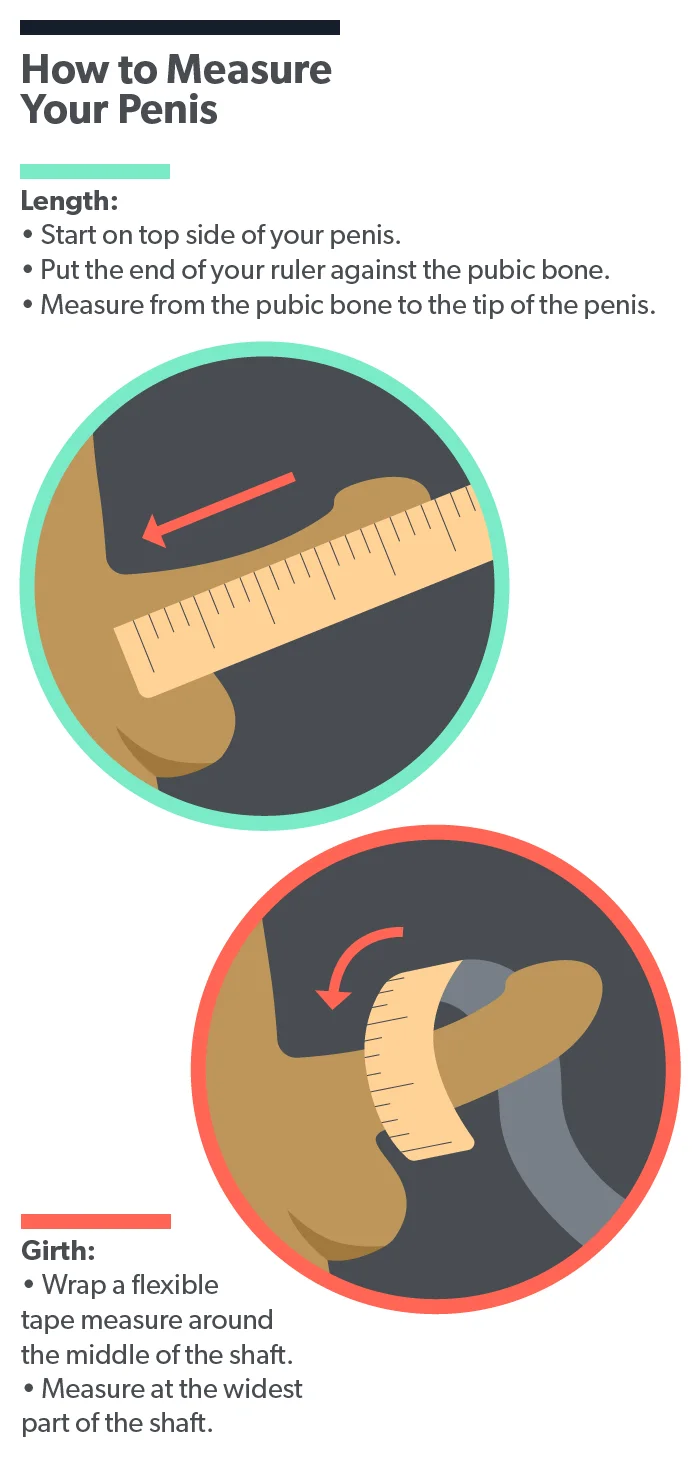Here's what we'll cover
Here's what we'll cover
Condom size matters—maybe more than you realize.
A poorly fitted condom can cause performance issues, such as condom-associated erectile problems and an inability to ejaculate, which might lead to condom anxiety. It can also raise your risk for sexually transmitted infections (STIs) and unplanned pregnancy (Beksinska, 2020; Wainipitapong, 2021).
Given these risks, it may surprise you to learn that nearly half of men aged 18 to 67 say they had used a badly fitting condom during the previous three months (Crosby, 2010).
If you fall into that group, or if you just want to learn a bit more about condom sizing, here’s how to measure yourself for a perfect condom fit, how to know what size condom to buy, and other details on how condom sizes work and how to have safer sex.
How to know what condom size to buy
As with clothing, condom sizes can vary from one manufacturer to the next. One maker’s “standard condom”, “snug fit” or “extra-large size” may not be the same as another’s. The days of condoms coming in just two sizes—regular condoms and XXL or “magnums”—are long gone.
However, most of the big condom brands now provide condom length and condom width information for their products. If you know your own measurements, you should be able to shop confidently for the best condoms for you despite all the different sizes now available (Cecil, 2017).
Finding your measurements
To identify what size condom you need, you’ll need to measure the length and the width of your penis with a tape measure or ruler and a piece of string. Once you know these two measurements, you can check different brands in the store or online and choose a condom that most closely matches your erect penis size.
You should have a full erection while measuring. Also, be honest with yourself when it comes to your measurements. Some research has found that when men self-measure their erections, they may exaggerate their figures (King, 2019).
Measure penis length
While fully erect, measure how long your penis is from its base to its tip. Do this with the ruler or measuring tape running along the top of your penis, not on the side or underneath.
You’ll want to gently push the ruler or tape measure into your lower abdomen so that it touches your pubic bone. That’s the bone you can feel with your fingers if you press in at the base of your penis (Veale, 2014).
Measure penis width
Using a piece of string, wrap it around the thickest part of your erect penis. This could be the base or the middle. Be sure you’re not squeezing your penis with the string, which could lead to a bad measurement. Mark down the size. This is the girth of your penis, also known as its circumference (Veale, 2014).
To get your width—aka, the diameter of your penis—divide your girth measurement by 3.14. This is sometimes noted on the condom’s packaging as the “nominal width,” which means the width of the condom when it is rolled.

Finding the “right” condom size
There is no true average or “standard size” when it comes to today’s condom sizes, but you (as well as condom manufacturers) may still be wondering about average penis sizes.
Different studies have come up with slightly different figures. But a 2015 research review found that the average erect penis size is 5.17 inches long (13.12 cm). And the average erect penis circumference (aka “girth”) is 4.59 inches (9.31 cm) (Veale, 2014). (if you’re wondering what qualifies as a “micropenis,” some researchers have defined it as anything less than 3.3 inches—and, yes, there are condoms on the market available if these are your measurements)
Of course, condom manufacturers are well aware of these statistics and design most standard condoms to fit these averages. Looking at size recs from one popular condom manufacturer, the “standard” condom size will be right for you if your penis is between 5 and 7 inches long, with a girth of 4-5 inches. If you’re bigger than 7 inches, this condom manufacturer recommends their “large/XL” product (Trojan, n.d.).
The bottom line here is that it’s important to find condoms that fit you properly—particularly if you’ve had condoms break, or if what you’re using seems too small. Fortunately, these days you have options. But remember, every brand is different, and your condom size may be different when using different brands. If you want the right fit, you really need to measure yourself and check it against the manufacturer’s specs. You may even want to buy several types of condoms to compare how well they fit.
What happens if a condom is too small or too big?
A condom’s size can affect how well it works. You want a snug fit, like a “second skin”. But if the condom is too small, it may be more likely to break. If it’s too large, this can lead to slippage. Both condom breaks and slippage can raise your risk for a sexually transmitted infection and unwanted pregnancy (Cecil, 2010).
Other research has found that roughly 1 in 5 men has experienced erection issues while trying to have sex using a condom. If they’re too small, condoms can mess with your ability to get or keep an erection because they can cut off circulation and make it difficult for blood to enter the penis. When a condom is too large, it can interfere with stimulation, making it more difficult to get and stay hard (Sanders, 2015).
In summary: once you’ve measured the length and width of your penis, you can select a properly sized condom. Condom size descriptions can vary from brand to brand, so you may want to buy several types to compare how well they fit and find one that is comfortable and offers full protection. You can make it fun! Practice putting the condom on by yourself without a partner. Masturbating with a condom on and exploring ways you can feel pleasure while wearing it not only helps you find the best fitting condom—it can also help get rid of any negative associations with condoms.
DISCLAIMER
If you have any medical questions or concerns, please talk to your healthcare provider. The articles on Health Guide are underpinned by peer-reviewed research and information drawn from medical societies and governmental agencies. However, they are not a substitute for professional medical advice, diagnosis, or treatment.
Beksinska, M., Wong, R., & Smit, J. (2020). Male and female condoms: Their key role in pregnancy and STI/HIV prevention. Best Practice & Research. Clinical Obstetrics & Gynaecology , 66 , 55–67. doi: 10.1016/j.bpobgyn.2019.12.001. Retrieved from https://pubmed.ncbi.nlm.nih.gov/32007451/
Cecil, M., Nelson, A. L., Trussell, J., & Hatcher, R. (2010). If the condom doesn't fit, you must resize it. Contraception , 82 (6), 489–490. doi: 10.1016/j.contraception.2010.06.007. Retrieved from https://www.ncbi.nlm.nih.gov/pmc/articles/PMC5512290/
Cecil, M., Warner, L., & Siegler, A. J. (2013). Online purchases of an expanded range of condom sizes in comparison to current dimensional requirements allowable by US national standards. Sexual Health , 10 (5), 408–413. doi: 10.1071/SH13049. Retrieved from https://www.publish.csiro.au/sh/sh13049
Crosby, R. A., Yarber, W. L., Graham, C. A., & Sanders, S. A. (2010). Does it fit okay? Problems with condom use as a function of self-reported poor fit. Sexually Transmitted Infections, 86 (1): 36-38 . doi: 10.1136/sti.2009.036665. Retrieved from https://pubmed.ncbi.nlm.nih.gov/20157178/
King, B. M., Duncan, L. M., Clinkenbeard, K. M., Rutland, M. B., & Ryan, K. M. (2019). Social Desirability and Young Men's Self-Reports of Penis Size. Journal of Sex & Marital Therapy , 45 (5), 452–455. doi: 10.1080/0092623X.2018.1533905. Retrieved from https://www.tandfonline.com/doi/pdf/10.1080/0092623X.2018.1533905
Mahdy, H., Shaeffer, A., & McNabb D. (2021). Condoms. [Updated Apr. 26, 2021]. In: StatPearls [Internet]. Retrieved from https://pubmed.ncbi.nlm.nih.gov/29261966/
Reece, M., Herbenick, D., Sanders, S. A., Monahan, P., Temkit, M., & Yarber, W. L. (2008). Breakage, slippage and acceptability outcomes of a condom fitted to penile dimensions. Sexually Transmitted Infections , 84 (2), 143–149. doi: org/10.1136/sti.2007.028316. Retrieved from https://sti.bmj.com/content/84/2/143.short
Trojan. (n.d). Condoms size and fit guide. Retrieved Jan. 26, 2022 from https://www.trojan.ca/en/sex-information/condom-size-fit-guide
Veale, D., Miles, S., Bramley, S., Muir, G., & Hodsoll, J. (2015). Am I normal? A systematic review and construction of nomograms for flaccid and erect penis length and circumference in up to 15 521 men. BJU International, 115 (6), 978–986. doi: 10.1111/bju.13010. Retrieved from https://bjui-journals.onlinelibrary.wiley.com/doi/abs/10.1111/bju.13010
Wainipitapong, S., Wiwattarangkul, T., & Bumphenkiatikul, T. (2021). Delayed Ejaculation Due to Improper Male Condom Size: A Case Report. Sexual Medicine , 9 (3), 100373. doi: 10.1016/j.esxm.2021.100373. Retrieved from https://www.sciencedirect.com/science/article/pii/S2050116121000532










